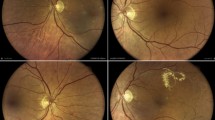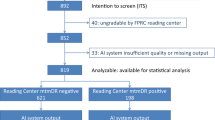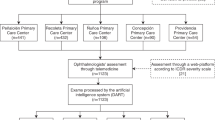Abstract
Purpose
Early detection and treatment of diabetic retinopathy (DR) are critical for decreasing the risk of vision loss and preventing blindness. Community vision screenings may play an important role, especially in communities at higher risk for diabetes. To address the need for increased DR detection and referrals, we evaluated the use of artificial intelligence (AI) for screening DR.
Methods
Patient images of 124 eyes were obtained using a 45° Canon Non-Mydriatic CR-2 Plus AF retinal camera in the Department of Endocrinology Clinic (Newark, NJ) and in a community screening event (Newark, NJ). Images were initially classified by an onsite grader and uploaded for analysis by EyeArt, a cloud-based AI software developed by Eyenuk (California, USA). The images were also graded by an off-site retina specialist. Using Fleiss kappa analysis, a correlation was investigated between the three grading systems, the AI, onsite grader, and a US board-certified retina specialist, for a diagnosis of DR and referral pattern.
Results
The EyeArt results, onsite grader, and the retina specialist had a 79% overall agreement on the diagnosis of DR: 86 eyes with full agreement, 37 eyes with agreement between two graders, 1 eye with full disagreement. The kappa value for concordance on a diagnosis was 0.69 (95% CI 0.61–0.77), indicating substantial agreement. Referral patterns by EyeArt, the onsite grader, and the ophthalmologist had an 85% overall agreement: 96 eyes with full agreement, 28 eyes with disagreement. The kappa value for concordance on “whether to refer” was 0.70 (95% CI 0.60–0.80), indicating substantial agreement. Using the board-certified retina specialist as the gold standard, EyeArt had an 81% accuracy (101/124 eyes) for diagnosis and 83% accuracy (103/124 eyes) in referrals. For referrals, the sensitivity of EyeArt was 74%, specificity was 87%, positive predictive value was 72%, and negative predictive value was 88%.
Conclusions
This retrospective cross-sectional analysis offers insights into use of AI in diabetic screenings and the significant role it will play in automated detection of DR. The EyeArt readings were beneficial with some limitations in a community screening environment. These limitations included a decreased accuracy in the presence of cataracts and the functional cost of EyeArt uploads in a community setting.


Similar content being viewed by others
Abbreviations
- AI:
-
Artificial intelligence
- BMI:
-
Body mass index
- DLAI:
-
Deep learning artificial intelligence
- DR:
-
Diabetic retinopathy
- T2DM:
-
Type II diabetes mellitus
- VTDs:
-
Vision-threatening diseases
References
Prevention CFDCa (2022) National diabetes statistics report. National Diabetes Statistics Report Website
Control CFD (2020) Prevalence of prediabetes among adults. Diabetes. CDC
National Diabetes Statistics Report (2020) Centers for disease control and prevention
Gruss SM, Nhim K, Gregg E, Bell M, Luman E, Albright A (2019) Public health approaches to type 2 diabetes prevention: the US National Diabetes Prevention Program and beyond. Curr Diabetes Rep 19:1–11
Lawrenson JG, Graham-Rowe E, Lorencatto F, Burr J, Bunce C, Francis JJ et al (2018) Interventions to increase attendance for diabetic retinopathy screening. Cochrane Database Syst Rev 1:CD012054
Cha AE, Villarroel MA, Vahratian A (2019) Eye disorders and vision loss among US adults aged 45 and over with diagnosed diabetes, 2016–2017
Hudson SM, Modjtahedi BS, Altman D, Jimenez JJ, Luong TQ, Fong DS (2022) Factors affecting compliance with diabetic retinopathy screening: a qualitative study comparing English and Spanish speakers. Clin Ophthalmol 16:1009–1018
Grzybowski A, Brona P, Lim G, Ruamviboonsuk P, Tan GS, Abramoff M et al (2020) Artificial intelligence for diabetic retinopathy screening: a review. Eye 34(3):451–460
Coney JM, Scott AW (2022) Racial disparities in the screening and treatment of diabetic retinopathy. J Natl Med Assoc 114(2):171–181
Fathy C, Patel S, Sternberg P Jr, Kohanim S (2016) Disparities in adherence to screening guidelines for diabetic retinopathy in the United States: a comprehensive review and guide for future directions. Semin Ophthalmol 31:364–377
Stark A (2018) FDA permits marketing of artificial intelligence-based device to detect certain diabetes-related eye problems. FDA, Silver Spring
Eyenuk (2020) Eyenuk announces FDA clearance for EyeArt autonomous AI system for diabetic retinopathy screening. https://www.eyenuk.com/us-en/articles/diabetic-retinopathy/eyenuk-announces-eyeart-fda-clearance/. Accessed 2022
Bhaskaranand M, Ramachandra C, Bhat S, Cuadros J, Nittala MG, Sadda SR et al (2019) The value of automated diabetic retinopathy screening with the EyeArt system: a study of more than 100,000 consecutive encounters from people with diabetes. Diabetes Technol Ther 21(11):635–643
Thylefors B, Chylack L Jr, Konyama K, Sasaki K, Sperduto R, Taylor H et al (2002) A simplified cataract grading system the WHO cataract grading group. Ophthal Epidemiol 9(2):83–95
Lim JI, Regillo CD, Sadda SR, Ipp E, Bhaskaranand M, Ramachandra C et al (2023) Artificial intelligence detection of diabetic retinopathy: subgroup comparison of the EyeArt system with ophthalmologists’ dilated examinations. Ophthalmol Sci 3(1):100228
Ipp E, Liljenquist D, Bode B, Shah VN, Silverstein S, Regillo CD et al (2021) Pivotal evaluation of an artificial intelligence system for autonomous detection of referrable and vision-threatening diabetic retinopathy. JAMA Netw Open 4(11):e2134254
Vought R, Vought V, Tailor P, Szirth B, Khouri AS. Tele-robotic ophthalmic consultation
Sommer AC, Blumenthal EZ (2020) Telemedicine in ophthalmology in view of the emerging COVID-19 outbreak. Graefe’s Arch Clin Exp Ophthalmol 258:2341–2352
Acknowledgements
This work was supported by the New Jersey Health Foundation.
Funding
Author Dr. N Bhagat receives grant funding from New Jersey Health Foundation. The New Jersey Health Foundation was not involved in the study design, data collection, analysis, interpretation, and in the decision to submit this article for publication. All other authors certify that they have no affiliations with or involvement in any organization or entity with any financial interest, or non-financial interest in the subject matter or materials discussed in this manuscript.
Author information
Authors and Affiliations
Contributions
Study conceptualization was completed by Ms. RV, Dr. NB, and Dr. BS. Dr. NB was responsible for funding acquisition. Data collection was performed by Ms. RV, Ms. VV, and Dr. BS. Images were read and analyzed by Dr NB. Data analysis was performed by Ms. VV and Mr. MS. All authors contributed to the writing of the manuscript. Dr. BS and Dr. NB were responsible for the supervision of the study. All authors approved the final manuscript.
Corresponding author
Ethics declarations
Conflict of interest
Author Dr. B Szirth receives grant funding from New Jersey Health Foundation. The New Jersey Health Foundation was not involved in the study design, data collection, analysis, interpretation, and in the decision to submit this article for publication. All other authors certify that they have no affiliations with or involvement in any organization or entity with any financial interest, or non-financial interest in the subject matter or materials discussed in this manuscript. The authors declare that they have no conflict of interest.
Ethics approval
This study was approved by the Rutgers University Institutional Review Board (Pro20140001070) and is in compliance with the World Medical Association’s Declaration of Helsinki.
Consent to participate
Informed consent was obtained from all individual participants included in the study.
Consent to publish
Not applicable.
Additional information
Publisher's Note
Springer Nature remains neutral with regard to jurisdictional claims in published maps and institutional affiliations.
Rights and permissions
Springer Nature or its licensor (e.g. a society or other partner) holds exclusive rights to this article under a publishing agreement with the author(s) or other rightsholder(s); author self-archiving of the accepted manuscript version of this article is solely governed by the terms of such publishing agreement and applicable law.
About this article
Cite this article
Vought, R., Vought, V., Shah, M. et al. EyeArt artificial intelligence analysis of diabetic retinopathy in retinal screening events. Int Ophthalmol 43, 4851–4859 (2023). https://doi.org/10.1007/s10792-023-02887-9
Received:
Accepted:
Published:
Issue Date:
DOI: https://doi.org/10.1007/s10792-023-02887-9




